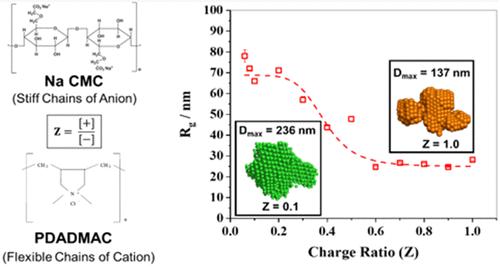Positional Correlation Length-Induced Morphological Transformation of Interpolyelectrolyte Complexes (IPECs) Made of Polysaccharides: The Role of Molar Charge Ratio
IF 5.2
1区 化学
Q1 POLYMER SCIENCE
引用次数: 0
Abstract
By combination of oppositely charged polyelectrolytes, one can form interpolyelectrolyte complexes (IPECs) that may serve, for example, as water-based delivery systems. Such macromolecular IPECs may exhibit broad size and shape distributions; thus, quantitative structural analysis is often prone to misinterpretation. By means of small-angle neutron scattering (SANS), we present a systematic analysis of the internal macromolecular structures of interpolyelectrolyte complexes (IPECs) in a quantitative fashion. As a model system, we study polyelectrolyte mixtures of anionic biosourced sodium carboxymethyl cellulose (NaCMC) and cationic synthetic poly(diallyldimethylammonium chloride) (PDADMAC). By integrating model-independent and model-dependent approaches, we reveal a morphological transformation from larger globular aggregates to smaller, multimodal lumpy structures with increasing molar charge ratio, i.e., upon approaching charge equimolarity. At the same time, the aggregates undergo significant compaction, driven by local structuring and a reduction in the characteristic correlation length of charge distribution, and they become increasingly anisometric. Additionally, the complexes retain a substantial amount of solvation water, which is gradually released as the charge ratio approaches equimolarity.

位置相关长度诱导的多糖多电解质间配合物(ipec)的形态转变:摩尔电荷比的作用
通过结合带相反电荷的聚电解质,可以形成聚电解质间复合物(ipec),例如,它可以作为水基输送系统。这种大分子ipec可能具有广泛的尺寸和形状分布;因此,定量结构分析往往容易产生误解。利用小角中子散射(SANS)技术,对多电解质间复合物(ipec)的内部大分子结构进行了定量分析。作为一个模型系统,我们研究了阴离子生物源羧甲基纤维素钠(NaCMC)和阳离子合成聚二烯基二甲基氯化铵(PDADMAC)的聚电解质混合物。通过整合模型独立和模型依赖的方法,我们揭示了随着摩尔电荷比的增加,即在接近电荷等摩尔时,从较大的球状聚集体到较小的多模态块状结构的形态转变。同时,在局部结构和电荷分布特征相关长度减小的驱动下,聚集体发生了显著的压实,并变得越来越不对称。此外,配合物保留了大量的溶剂化水,当电荷比接近等摩尔时,这些水逐渐释放出来。
本文章由计算机程序翻译,如有差异,请以英文原文为准。
求助全文
约1分钟内获得全文
求助全文
来源期刊

Macromolecules
工程技术-高分子科学
CiteScore
9.30
自引率
16.40%
发文量
942
审稿时长
2 months
期刊介绍:
Macromolecules publishes original, fundamental, and impactful research on all aspects of polymer science. Topics of interest include synthesis (e.g., controlled polymerizations, polymerization catalysis, post polymerization modification, new monomer structures and polymer architectures, and polymerization mechanisms/kinetics analysis); phase behavior, thermodynamics, dynamic, and ordering/disordering phenomena (e.g., self-assembly, gelation, crystallization, solution/melt/solid-state characteristics); structure and properties (e.g., mechanical and rheological properties, surface/interfacial characteristics, electronic and transport properties); new state of the art characterization (e.g., spectroscopy, scattering, microscopy, rheology), simulation (e.g., Monte Carlo, molecular dynamics, multi-scale/coarse-grained modeling), and theoretical methods. Renewable/sustainable polymers, polymer networks, responsive polymers, electro-, magneto- and opto-active macromolecules, inorganic polymers, charge-transporting polymers (ion-containing, semiconducting, and conducting), nanostructured polymers, and polymer composites are also of interest. Typical papers published in Macromolecules showcase important and innovative concepts, experimental methods/observations, and theoretical/computational approaches that demonstrate a fundamental advance in the understanding of polymers.
 求助内容:
求助内容: 应助结果提醒方式:
应助结果提醒方式:


